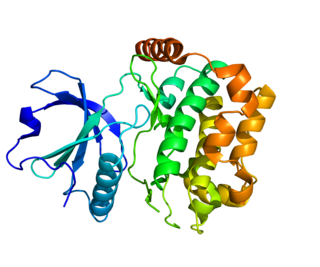| STK17A | |||||||||||||||||||||||||||||||||||||||||||||||||||
|---|---|---|---|---|---|---|---|---|---|---|---|---|---|---|---|---|---|---|---|---|---|---|---|---|---|---|---|---|---|---|---|---|---|---|---|---|---|---|---|---|---|---|---|---|---|---|---|---|---|---|---|
| Identifiers | |||||||||||||||||||||||||||||||||||||||||||||||||||
| Aliases | STK17A , DRAK1, serine/threonine kinase 17a | ||||||||||||||||||||||||||||||||||||||||||||||||||
| External IDs | OMIM: 604726 HomoloGene: 55846 GeneCards: STK17A | ||||||||||||||||||||||||||||||||||||||||||||||||||
| |||||||||||||||||||||||||||||||||||||||||||||||||||
| |||||||||||||||||||||||||||||||||||||||||||||||||||
| |||||||||||||||||||||||||||||||||||||||||||||||||||
| |||||||||||||||||||||||||||||||||||||||||||||||||||
| Wikidata | |||||||||||||||||||||||||||||||||||||||||||||||||||
| |||||||||||||||||||||||||||||||||||||||||||||||||||
Serine/threonine kinase 17a is a protein that in humans is encoded by the STK17A gene. [3]
| STK17A | |||||||||||||||||||||||||||||||||||||||||||||||||||
|---|---|---|---|---|---|---|---|---|---|---|---|---|---|---|---|---|---|---|---|---|---|---|---|---|---|---|---|---|---|---|---|---|---|---|---|---|---|---|---|---|---|---|---|---|---|---|---|---|---|---|---|
| Identifiers | |||||||||||||||||||||||||||||||||||||||||||||||||||
| Aliases | STK17A , DRAK1, serine/threonine kinase 17a | ||||||||||||||||||||||||||||||||||||||||||||||||||
| External IDs | OMIM: 604726 HomoloGene: 55846 GeneCards: STK17A | ||||||||||||||||||||||||||||||||||||||||||||||||||
| |||||||||||||||||||||||||||||||||||||||||||||||||||
| |||||||||||||||||||||||||||||||||||||||||||||||||||
| |||||||||||||||||||||||||||||||||||||||||||||||||||
| |||||||||||||||||||||||||||||||||||||||||||||||||||
| Wikidata | |||||||||||||||||||||||||||||||||||||||||||||||||||
| |||||||||||||||||||||||||||||||||||||||||||||||||||
Serine/threonine kinase 17a is a protein that in humans is encoded by the STK17A gene. [3]
This gene is a member of the death-associated protein (DAP) kinase-related apoptosis-inducing protein kinase family and encodes an autophosphorylated nuclear protein with a protein kinase domain. The protein has apoptosis-inducing activity. [3]
In a recent study the gene (among others) shows a major role in centenarians longer lifespan. [4]

Protein kinase C delta type is an enzyme that in humans is encoded by the PRKCD gene.

Protein kinase C beta type is an enzyme that in humans is encoded by the PRKCB gene.

Serine/threonine-protein kinase PAK 2 is an enzyme that in humans is encoded by the PAK2 gene.

Death-associated protein kinase 1 is an enzyme that in humans is encoded by the DAPK1 gene.

Calcium/calmodulin-dependent protein kinase type IV is an enzyme that in humans is encoded by the CAMK4 gene.

Mitogen-activated protein kinase kinase kinase 3 is an enzyme that in humans is encoded by the MAP3K3 gene, which is located on the long arm of chromosome 17 (17q23.3).

Serine/threonine-protein kinase 4 is an enzyme that in humans is encoded by the STK4 gene.

Ribosomal protein S6 kinase alpha-1 is an enzyme that in humans is encoded by the RPS6KA1 gene.

5'-AMP-activated protein kinase catalytic subunit alpha-1 is an enzyme that in humans is encoded by the PRKAA1 gene.

Receptor-interacting serine/threonine-protein kinase 2 is an enzyme that in humans is encoded by the RIPK2 gene.

TBK1 is an enzyme with kinase activity. Specifically, it is a serine / threonine protein kinase. It is encoded by the TBK1 gene in humans. This kinase is mainly known for its role in innate immunity antiviral response. However, TBK1 also regulates cell proliferation, apoptosis, autophagy, and anti-tumor immunity. Insufficient regulation of TBK1 activity leads to autoimmune, neurodegenerative diseases or tumorigenesis.

PITSLRE serine/threonine-protein kinase CDC2L1 is an enzyme that in humans is encoded by the CDC2L1 gene.

Serine/threonine-protein kinase 3 is an enzyme that in humans is encoded by the STK3 gene.

Homeodomain-interacting protein kinase 3 is an enzyme that in humans is encoded by the HIPK3 gene.

Fas-activated serine/threonine kinase is an enzyme that in humans is encoded by the FASTK gene.

Serine/threonine-protein kinase TAO2 is an enzyme that in humans is encoded by the TAOK2 gene.

Receptor-interacting serine/threonine-protein kinase 3 is an enzyme that is encoded by the RIPK3 gene in humans.

Maternal embryonic leucine zipper kinase (MELK) is an enzyme that in humans is encoded by the MELK gene. MELK is a serine/threonine kinase belonging to the family of AMPK/Snf1 protein kinases. MELK was first identified present as maternal mRNA in mouse embryos. MELK expression is elevated in a number of cancers and is an active research target for pharmacological inhibition.

Serine/threonine-protein kinase 24 is an enzyme that in humans is encoded by the STK24 gene located in the chromosome 13, band q32.2. It is also known as Mammalian STE20-like protein kinase 3 (MST-3). The protein is 443 amino acids long and its mass is 49 kDa.

Receptor-interacting serine/threonine-protein kinase 4 is an enzyme that in humans is encoded by the RIPK4 gene.
This article incorporates text from the United States National Library of Medicine, which is in the public domain.